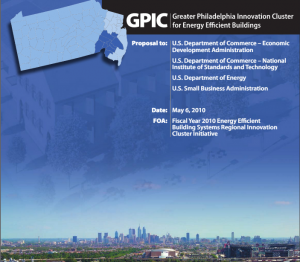
Publication Date: May 6, 2010
The goals of the Greater Philadelphia Innovation Cluster (GPIC) for Energy Efficient Buildings are to improve energy efficiency and operability and reduce carbon emissions of new and existing buildings, focusing on full spectrum retrofit of existing average-size commercial and multi-family residential buildings, and to stimulate private investment and quality job creation in the Greater Philadelphia region and the larger Mid Atlantic region, and beyond.
Greater Philadelphia is an interconnected, well-defined and historically recognized region comprising ten contiguous counties situated in Southeastern Pennsylvania and Southwestern New Jersey with the City of Philadelphia at its heart and occupying in excess of 3,800 square miles. The location for the DOE HUB/GPIC is the Clean Energy Campus at the Navy Yard in Philadelphia. The Navy Yard, which was closed by the federal government in 1996, represents one of the nation’s largest and most dynamic redevelopment opportunities. The 1,200 acre site currently houses more than 90 companies with more than 7,000 employees and is poised for continued strategic investment and growth in the years ahead.
A cornerstone of the Navy Yard redevelopment effort is the Clean Energy Campus, aimed at making the Navy Yard a national center of excellence for energy research, education, and commercialization. The Clean Energy Campus currently houses the DOE Mid Atlantic Clean Energy Applications Center, the DOE Northern Mid Atlantic Solar Training Center, and the DOE Grid Smart Training Applications Resource (GridSTAR) Center.
The DOE HUB comprises a uniquely dynamic and diversified team of 11 prestigious academic institutions including a historically black university, two DOE laboratories, five high profile global industry partners, regional economic development agencies, and community colleges. DOE HUB activities are organized into five tasks, which are: 1) tools for integrated design, verification, and modeling; 2) components, diagnostics, sub-systems, and controls; 3) public policy, behavior, economics, and business; 4) education and workforce development; and 5) demonstration, knowledge management and deployment.
DOE HUB headquarters facilities will include two buildings at the Navy Yard which will house HUB personnel. A historic building will undergo a major retrofit and a new advanced integrated building sciences laboratory will be constructed. These facilities will function as living laboratories from design, through construction, commissioning and operation for developing tools and methods to transform the industry’s current fragmented serial process into system performance driven, integrated, parallel, team processes. The Commonwealth of Pennsylvania has committed $30 million of new capital funding to support these facilities.
The GPIC is the culmination of many years of dedicated team building efforts. More than 60 GPIC partners from government, industry, education and workforce development, banking and finance, labor, and philanthropic foundations have made commitments to the GPIC. The DOE HUB and the GPIC are tightly integrated. The EDA, NIST, and SBA co-applicants all are represented on the DOE HUB /GPIC Executive Board, and all serve as DOE HUB members.
The management of the DOE HUB /GPIC utilizes state-of –the-art communications and information technology and blends hierarchical control with decentralization, promoting day-to-day teamwork but also providing authoritative decision-making when needed. The heart of the enterprise is the collaborative Operating Committee comprising the five DOE HUB task leaders (two from industry, two from academia, one from a regional economic development agency), the Navy Yard test bed facilities manager, and the Deputy Director. Ultimate decision making authority, however, rests with the DOE HUB /GPIC Director and the Executive Board.
Consortium Member(s): Bayer Material Science,Ben Franklin Technology Partners of SE PA (BFTP),Carnegie Mellon University,Delaware Valley Industrial Resource Center (DVIRC),Drexel University,Morgan State University,New Jersey Institute of Technology (NJIT),Philadelphia Industrial Development Corporation (PIDC),Purdue University,Rutgers University,The Pennsylvania State University,United Technologies Research Center (UTRC),University of Pennsylvania,Virginia Tech
Project contact: Thomas F. Massaro